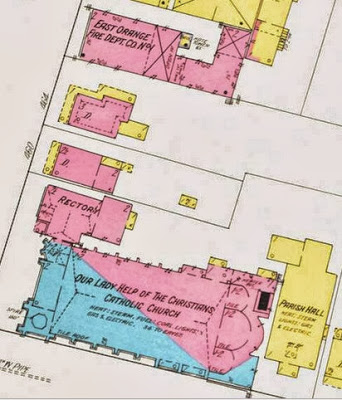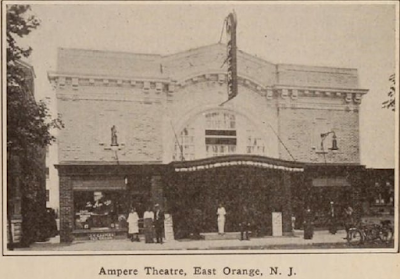Wednesday, November 26, 2014
Saturday, November 22, 2014
East Orange in the novel The Human Stain
The Human Stain is a 2000 novel by Philip Roth, and the protagonist is Coleman Silk, a 1944 graduate of East Orange High School. In the section below, at the novel's end which takes place in the late 1990's, Silk's sister reminisces about life in East Orange before 1955.
“In my parents' day and age, it used to be the person who fell short. Now it's the discipline. Reading the classics is too difficult, therefore it's the classics that are to blame. Today the student asserts his incapacity as a privilege. I can't learn it, so there is something wrong with it. And there is something especially wrong with the bad teacher who wants to teach it. There are no more criteria, Mr. Zuckerman, only opinions. I often wrestle with this question of what everything used to be. What education used to be. What East Orange High used to be. What East Orange used to be. Urban renewal destroyed East Orange, there's no doubt in my mind. They---the city fathers---talked about all the great things that were going to happen because of the urban renewal. It scared the merchants to death and the merchants left, and the more the merchants left, the less business there was. Then 280 and the Parkway cut our little town in quarters. The Parkway eliminated Jones Street---the center of our colored community the Parkway eliminated altogether. Then 280. A devastating intrusion. What that did to the community! Because the highway had to come through, the nice houses along Oraton Parkway, Elmwood Avenue, Maple Avenue, the state just bought them up and they disappeared overnight. I used to be able to do all my Christmas shopping on Main Street. Well, Main Street and Central Avenue. Central Avenue was called the 5th Avenue of the Oranges then. You know what we've got today? We've got a ShopRite. And we've got a Dunkin' Donuts. And there was a Domino's Pizza, but they closed. Now they've got another food place. And there's a cleaners. But you can't compare quality. It's not the same. In all honesty, I drive up the hill to West Orange to shop.. But I didn't then. There was no reason to. Every night when we went out to walk the dog, I'd go with my husband, unless the weather was real bad---walk to Central Avenue, which is two blocks, then down Central Avenue for four blocks, cross over, then window-shop back, and home. There was a B. Altman, A Russek's. There was a Black, Starr, and Gorham. There was a Bachrach, the photographer. A very nice men's store, Mink's, that was a Jewish, that was over on Main Street. Two theaters. There was the Hollywood Theater on Central Avenue. There was the Palace Theater on Main Street. All of life was there in little East Orange..."
Actor Anthony Hopkins played Coleman Silk in the movie adaptation of The Human Stain. Hopkins was born in Great Britain (Wales) and one movie reviewer criticized the movie by writing "One of the great puzzlements of "The Human Stain" is the casting. Hopkins is a great actor, but with all his talent and craft he is not capable of suggesting that he has ever been within fifty miles of East Orange."
A pdf of The Human Stain is available at this link:
http://fidanhasani.weebly.com/uploads/1/0/6/9/10698738/roth_philip_-_the_human_stain17.pdf
Main Street in Orange, Early 20th Century
Above: looking west on Main Street across the Day Street intersection
Below: looking east across the Essex Avenue intersection
Below: the YMCA building that was built in 1887 on the west side of Grace Church

Below: looking east across the Essex Avenue intersection
Above: looking east across the Essex Avenue intersection
Below: looking west from Essex Avenue intersection, postmarked 1905
Above: looking west along Main Street with YMCA in distant center
Below: the YMCA building that was built in 1887 on the west side of Grace Church

Monday, November 17, 2014
The Ampere Theater
The Ampere Movie Theater was at 237 North 18th Street.
A 1917 article in Music Trade Review says an Ampere Theater corporation was formed at 380 Main St with $125,000 in capital
The building is now used as a church.
Below: from a 1943 Film article
In a 1945 movie theater guide, The Ampere is listed as having only 430 seats.
Joseph E. Rubenstein
March 07, 2006|The Morning Call
Joseph E. Rubenstein, 90, of Bethlehem, formerly of Wilson, died March 5. He was a son of the late Hyman and Bessie (Rubin) Rubenstein. He and his wife, Shirley Sobelson, were married for 67 years in August. He was a graduate of Ithaca College and served in Europe during World War II as a staff sergeant in the 102nd Ozark Infantry Division. He owned Ampere Theater, East Orange, N.J., and later worked for The Strand Shop, Bangor. He was a member of Temple Covenant of Peace, Easton, where he served as vice president and trustee for many years. He was a past president of the local Bnai Brith and the Jewish Community Council. He was a chairman of the Israel Bond and United Jewish Appeal drives. He was a member of Lafayette Masonic Lodge and the Jewish War Veterans, and was a volunteer for Easton Hospital.
Below: Coming attractions, 1950
Below: Coming attractions, 1950
Saturday, November 8, 2014
The Palace Movie Theater
From the July 22, 1916 issue of Moving Picture World
Below: St Petersberg Times, Oct 4, 1930
Below: In 1937 The Palace Theater was remodeled in Art Deco style.
Oct 2, 1930, The Olean Times Herald, Olean, NY
KEEP SUNDAY LAW WITH ROPE LENGTH (By United Press) Orange, N. J., Oct. 2.--The Palace moving-picture theater, which stands on the dividing line between this town and East Orange, with half of Its seats in one town and the other half In the other, will on future Sundays preserve the piety of East Orange with a length of rope. Orange Is legalizing Sunday moving pictures. But East Orange stands firmly against them, and Mayor Charles H. Martens of East Orange has announced he will rope off his half of the theater "to protect East Orange from the affects of Sunday movies in Orange."
Subscribe to:
Comments (Atom)























































